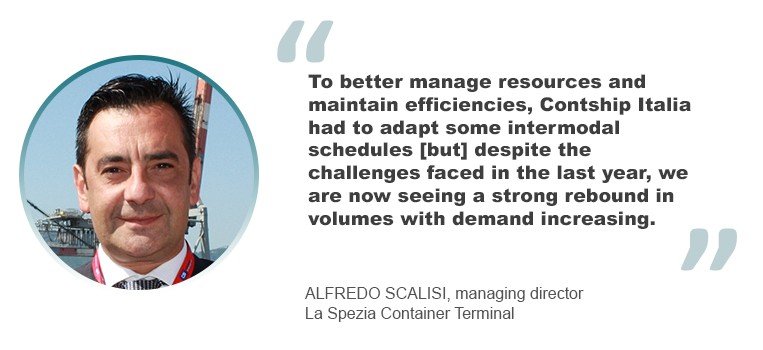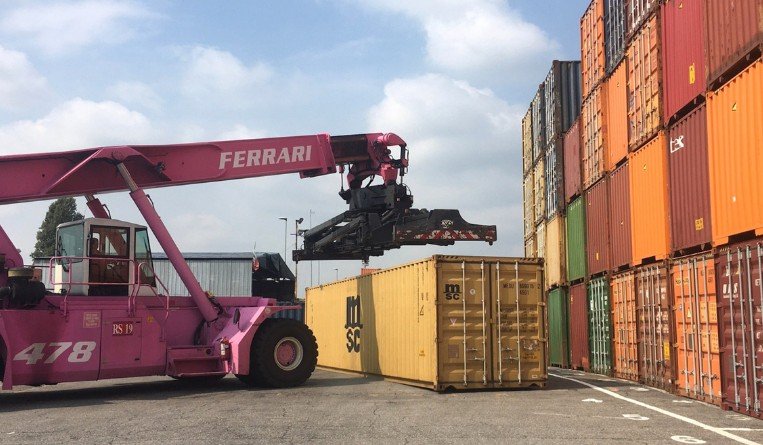Demand for rail freight is expected to further grow as the lingering coronavirus pandemic, among other factors, continues to restrict capacity through air and sea.
The rail freight option to Europe, for example, provided Asian shippers an affordable alternative, compared to air, when the reliability of containership schedules dropped to a record low. In terms of air transport, bellyhold space continues to be limited as most passenger planes remain grounded.
“During the initial Covid-19 global lockdown period, when ship transit was disrupted, many shippers saw rail freight as a desirable option,” Alfredo Scalisi, managing director of La Spezia Container Terminal, told Asia Cargo News.
He noted, for example, that as Italian port volumes “were impacted hard” – as were many ports around the world – with shipping lines implementing blank sailings, the regional gateway had to look into intermodal operations to move goods.
“Contship, with its maritime terminals in La Spezia (LSCT) and Ravenna (TCR) and its intermodal network, maintained throughout this pandemic a strong commitment to support the Southern Gateway logistics system, through efficient terminal operations and integrated high-frequency rail services, connecting Italian ports to the main logistic hubs, in Italy and across southern Europe,” Scalisi said.
“To better manage resources and maintain efficiencies, Contship Italia had to adapt some intermodal schedules,” he added, noting that “despite the challenges faced in the last year, we are now seeing a strong rebound in volumes with demand increasing.”

Expansion of rail services within Europe
Within Europe, Scalisi noted that Contship Italia’s multimodal transport operator, Hannibal, currently offers more than 150 weekly trains between main Italian and European destinations, out of which 120 directly operated by the group’s rail traction company Oceanogate Italia, using 11 locomotives and 435 wagons, offering faster transit times than competitors.
The LSCT executive said operating to and from Contship’s privately-owned terminal Rail Hub Milano (RHM) in Milan across the Alps to the southern Europe markets “will provide Asian customers with an alternative and an efficient routing via Italian ports to transport goods over the Alps to Austria, Switzerland, and southern Germany.”
He said Contship’s intermodal service also offers direct connectivity with short-sea services with the United Kingdom, Ireland and Portugal, avoiding the need for transfers via truck between rail and maritime terminal.
“We will continue to expand services to Rotterdam and the UK for continental volumes, by adding new corridors in 2021 and 2022,” Scalisi said.
Asked about the impact of Brexit to its operations, he said: “The major impact from Brexit on our intermodal business can be observed on the Milan (Melzo)-Rotterdam service, where volumes directed to and originated from the United Kingdom are often loaded.”
“Volumes on this route suffered from a temporary setback in January, when the shock of change hit transport operations across the English Channel,” Scalisi told Asia Cargo News, adding that data from February already show a “positive trend” as major operators consolidate new procedures and smaller agents overcome emerging organizational and bureaucratic hurdles.
Asia-Europe rail connections
In terms of its Asia connections, Scalisi said that during the second half of 2020, LSCT launched, in partnership with Rail Cargo Austria and DBO, a new rail service from Xi’an to RHM, offering a 14-16-day transit-time and providing opportunities of diversification and better risk-management for our customers’ supply chains.
He said the service is one of the two that links Italy with China via RHM and has enabled Contship Italia, alongside its sea offerings to “provide vital support to EU-China trade during the pandemic.”
In Melzo, he noted that during the second half of 2020, they received several special trains from China, transporting surgical masks and “melt blow” fabric.
“We think that the tight capacity in air and sea freight will facilitate the shift to rail freight, and we remain optimistic for the medium-term growth of this new intercontinental rail option, despite the persisting uncertainties about the global economic recovery,” Scalisi told Asia Cargo News.
To further enhance its China connectivity, LSCT opened its first Hannibal representative office in China and from March 2021, the executive noted that they have been testing a new rail service between Chengdu and Melzo. “Based on customers’ feedback we will then implement a regular service,” he added.
According to China State Railway Group Ltd., there were 12,400 China-Europe freight train trips in 2020, up 50% from 2019.
“Due to the tight capacity in air and container shortage in sea freight, demand continued to accelerate,” Scalisi said. “We believe the railway represents the present and the future of freight transport.”
Meanwhile, Siddique Khan, CEO of Globalink Logistics, a member of the Kerry Logistics Network, said that since the launch of China’s Belt and Road Initiative in 2014 and the subsequent development of the Khorgos Gateway Terminal on the Kazakhstan-China border, overall rail capacity has “increased significantly.”
“We anticipate traffic from China to Europe to grow. Besides the Suez Canal blockade, other factors are driving the volume on China-Europe New Eurasia Land Bridge Economic Corridor via Kazakhstan,” Khan told Asia Cargo News.
“One reason is the shifting supply chain as China is relocating its production inland toward western China. Moving cargo from western and central China to southern Chinese ports takes almost the same time and cost as moving freight toward the China-Kazakhstan border. Overall transit time from western China to Europe is 15-16 days, which is quite attractive for high-value goods compared to 35-40 days transit time from southern Chinese ports to Europe,” he added.
Charlee C. Delavin



